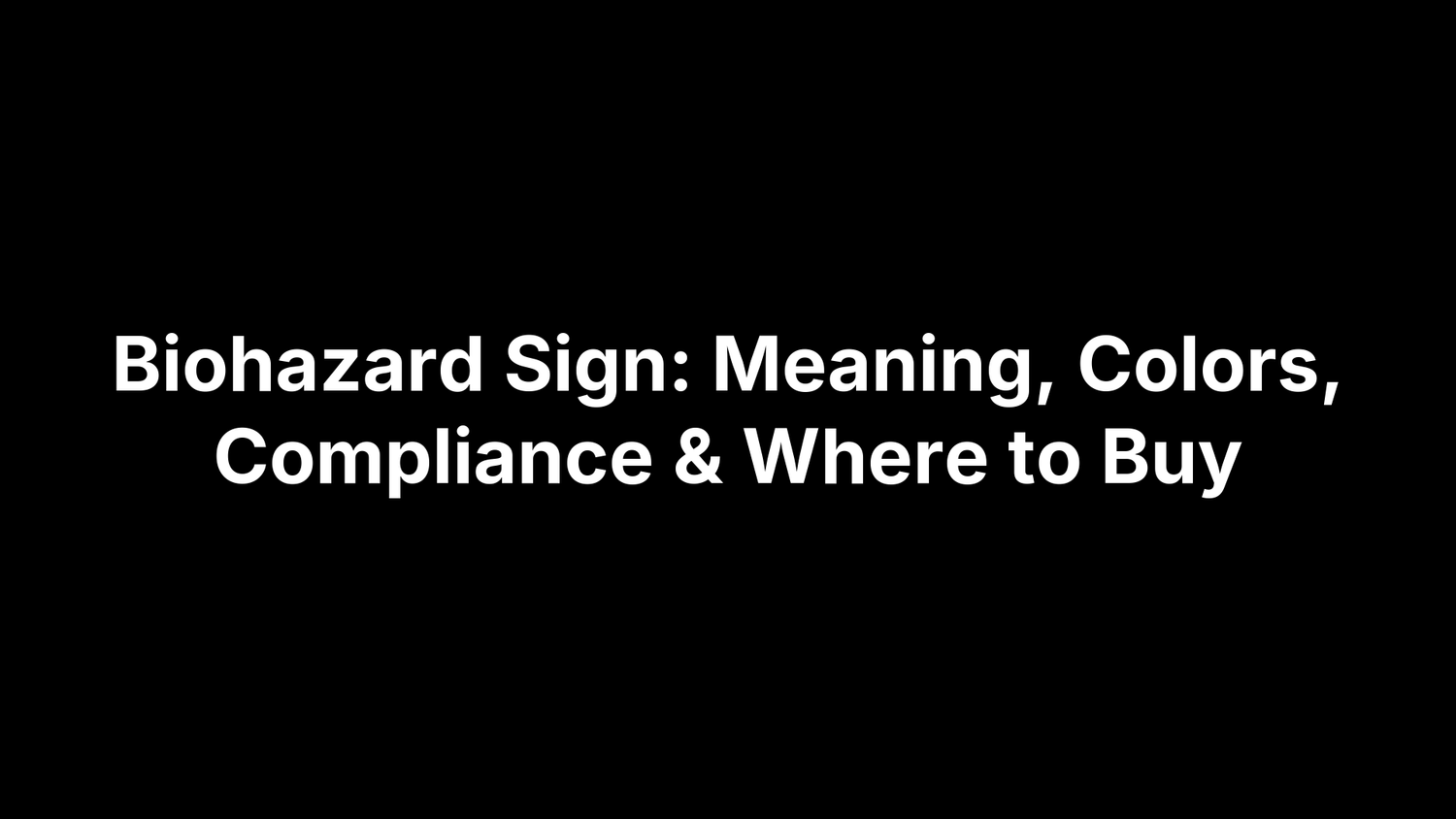Biohazard Sign: Meaning, Colors, Compliance & Where to Buy
A biohazard sign is the universal warning for biological risks—think bloodborne pathogens, infectious materials, contaminated equipment, and regulated medical waste. When you post this symbol, you’re telling people to use caution, follow specific entry and exit procedures, and handle materials with care. In short, it signals “potential infection risk present,” whether on a lab door, a sharps container, or a transport box.
This guide explains exactly what the biohazard sign means, when you must use it, and the compliant colors, wording, and symbol requirements set by OSHA and ANSI. You’ll see typical use cases (labs, clinics, shipping), lab door details by biosafety level (BSL-1 to BSL-3), container and waste labeling rules, size and placement tips, material options, the red vs fluorescent orange question, common mistakes, free printable templates, and where to buy compliant stock or custom signs.
What a biohazard sign means and when you need one
A biohazard sign tells people that infectious agents or potentially infectious materials are present and that special procedures, PPE, and restricted access apply. In practice, it’s your visual control for preventing exposure and contamination—especially in labs, clinics, and during transport and waste handling.
You need a biohazard sign when:
- Posting lab or room doors where biohazards are used to restrict access and state entry/exit requirements (typically BSL-2 and above, including ABSL-2/3).
- Labeling regulated medical waste containers and bags.
- Marking containers used to store, transport, or ship blood or other potentially infectious materials (OPIM) as required by OSHA’s Bloodborne Pathogens Standard.
Required colors, symbol, and wording (OSHA/ANSI)
OSHA’s Bloodborne Pathogens Standard (29 CFR 1910.1030) requires biohazard labels and signs to use a fluorescent orange or orange‑red background with the biohazard symbol and legend in a contrasting color. Use the standardized biohazard trefoil and clear wording so workers immediately recognize the hazard and know what precautions apply.
- Color: Fluorescent orange/orange‑red background; symbol and text in a contrasting color (commonly black).
- Symbol: Standard biohazard trefoil, large and prominent.
- Legend: The word BIOHAZARD must appear; add specific agents and required PPE/entry–exit procedures where applicable (common on lab door signs).
- ANSI formatting (optional): You may add an ANSI Z535-style signal word panel (DANGER/ WARNING) for clarity; match the header color to the signal word while keeping the biohazard panel in fluorescent orange/orange‑red.
Examples of biohazards and typical sign use cases
Biohazards include toxins, microorganisms (bacteria, viruses), and waste that can cause infection. A biohazard sign alerts staff and visitors to these risks and signals restricted access, PPE, and special handling to prevent exposures and cross‑contamination.
- Human blood and other potentially infectious materials (OPIM): label containers used to store, transport, or ship them.
- Regulated medical waste: mark collection and transport containers for clear hazard recognition.
- BSL‑2/BSL‑3 and ABSL‑2/3 lab rooms: post entry doors with required entry/exit procedures.
Where and when biohazard signs are required by OSHA
OSHA’s Bloodborne Pathogens Standard (29 CFR 1910.1030) requires a compliant biohazard sign or label whenever workers could encounter bloodborne pathogens through labeled items. The standard specifies a fluorescent orange or orange‑red background with the biohazard symbol and legend in a contrasting color, and it applies to storage, transport, and disposal points where exposure could occur.
Required on:
- Containers of regulated medical waste: bags, bins, and transport containers.
- Containers used to store, transport, or ship blood or other potentially infectious materials (OPIM): vials, coolers, secondary containers, and shipping boxes.
Note: Many institutions also require posting lab entry doors when biohazards are in use (e.g., BSL‑2/BSL‑3 rooms).
Lab door signage: what to include by biosafety level (BSL-1 to BSL-3)
Door signage is your first control for restricting access and communicating biohazards, procedures, and contacts. OSHA requires fluorescent orange/orange‑red biohazard signs and labels with a contrasting symbol and legend; many institutions (e.g., universities) mandate permanent door signs for BSL‑2/BSL‑3 rooms that spell out procedures and contacts.
- BSL‑1: Generally, a full biohazard warning sign isn’t required; the biohazard symbol is sufficient unless your institution specifies otherwise.
- BSL‑2: Post a permanent biohazard sign on entry doors. Include: biosafety level; biological agent(s); special procedures and required PPE; entry/exit precautions; any immunization or respiratory protection requirements; room number and posting date; PI(s) and an emergency contact with after‑hours phone.
- BSL‑3: Post and maintain the same elements as BSL‑2, with clear restricted‑access language and any heightened requirements (e.g., respiratory protection, immunizations). Keep the fluorescent orange/orange‑red background with a contrasting biohazard symbol and legend.
Labeling for containers, equipment, and regulated medical waste
Labeling is how you keep exposures from happening between point-of-use and final disposal. Under OSHA’s Bloodborne Pathogens Standard (29 CFR 1910.1030), apply a biohazard label with a fluorescent orange or orange‑red background and a contrasting symbol/legend wherever workers could encounter bloodborne pathogens during storage, transport, or disposal.
- Regulated medical waste: Mark bags, bins, and transport containers with the biohazard symbol and “BIOHAZARD” legend in a contrasting color.
- Blood/OPIM containers: Label any container used to store, transport, or ship blood or other potentially infectious materials (e.g., vials, coolers, secondary containers).
- Contaminated equipment: When equipment is contaminated or may be, affix a clear biohazard label and state needed precautions/PPE before service or movement.
- Label durability: Use labels that are permanent, legible, and resistant to handling, moisture, and routine cleaning.
Size, placement, and legibility best practices
Visibility drives compliance. Size your biohazard sign for the viewing distance, keep the fluorescent orange/orange‑red field unobstructed, and position it where workers first make entry or contact with containers, carts, or equipment. Prioritize clean contrast and straightforward wording so the hazard is understood at a glance.
- On doors, mount at eye height, on or immediately adjacent to the entry.
- Post at every entrance to the room/area.
- Preserve contrast: large trefoil, clear BIOHAZARD legend, matte finish.
- Maintain sightlines and lighting; avoid clutter, tinted glass, or obstructions.
- For containers/equipment, label primary and any overpack; keep labels upright and visible; replace if faded or damaged.
Materials and durability options for healthcare and industry
Choose materials for how the sign will be used: hospitals mean constant wipe‑downs and moisture; industrial areas add UV, oil, and abrasion. Prioritize constructions that keep the fluorescent orange/orange‑red vivid and legible after cleaning, and match adhesive to the surface (painted doors, stainless, poly bins, curved containers).
- Laminated vinyl: flexible, disinfectant‑resistant for containers and equipment.
- Polyester (PET): thin, high‑tack for smooth metals and plastics.
- Rigid plastic or aluminum: cleanable door plates; indoor/outdoor duty.
Red vs fluorescent orange biohazard signs: what’s correct?
Short answer: fluorescent orange or orange‑red. OSHA’s Bloodborne Pathogens Standard requires biohazard labels and signs to have a fluorescent orange/orange‑red background with the biohazard symbol and legend in a contrasting color. A solid red sign is not the required background for a biohazard label. If you use ANSI formatting, a red DANGER header may be used above—but the biohazard panel itself must remain fluorescent orange/orange‑red with a high‑contrast trefoil and BIOHAZARD legend.
Common compliance mistakes and how to avoid them
Even strong safety programs get tripped up by small sign and label errors that invite citations—and exposures. Use this quick list to tighten compliance and keep workers informed at the point of risk.
- Wrong color background: Avoid solid red or yellow. Use fluorescent orange/orange‑red with a contrasting symbol/legend per OSHA 1910.1030.
- Symbol only, no legend or too small: Include a large trefoil and the word BIOHAZARD; keep it prominent.
- Missing BSL door postings/details: For BSL‑2/3, post doors and list agents, PPE, entry/exit steps, PI(s), and after‑hours contact.
- Unlabeled containers/equipment: Label all blood/OPIM containers, overpacks, transport coolers, and contaminated equipment before movement or service.
- Poor placement/visibility: Mount at eye height, at every entrance; keep unobstructed and well lit.
- Non‑durable labels: Select disinfectant‑resistant, moisture‑proof materials; inspect and replace when faded or damaged.
Free printable biohazard sign templates (PDF, PNG, SVG)
Need a quick, compliant biohazard sign? Use printable templates (PDF, PNG, SVG) that meet OSHA 29 CFR 1910.1030: fluorescent orange/orange‑red background, contrasting trefoil, and BIOHAZARD legend. Print in color on 8.5×11 white stock and size for readability.
- BSL‑2/3 doors: include agents, PPE, entry/exit, PI, after‑hours contact.
- Don’t alter colors; avoid solid red. Preserve contrast when scaling.
- Laminate or use waterproof label stock; replace when damaged.
Where to buy compliant biohazard signs and custom labels
For compliant biohazard signs, choose a supplier that understands OSHA 29 CFR 1910.1030. Safety Decals (Tye’s Incorporated) offers stock and custom biohazard signs and labels built to the fluorescent orange/orange‑red requirements, with materials suited to healthcare and industry. Order with a simple sticker builder.
- Stock door, container, and waste labels: plus custom sizes and legends.
- Compliance-ready options: fluorescent orange/orange‑red panels, ANSI Z535 headers, agent/PPE fields.
The origin of the biohazard symbol and why the design works
In 1966, Dow’s Biohazards R&D team led by Charles Baldwin, under NCI, designed the biohazard symbol. They sought a “memorable and meaningless” mark, tested among 300 people, selecting the trefoil that scored high in memorability and low in prior meaning. Its symmetry, easy stenciling, fluorescent orange contrast, and universal readability led to ANSI (1969) and ISO (1986) standardization.
Quick compliance checklist
Use this one‑minute biohazard sign check before audits or posting new doors, containers, or equipment. It reflects OSHA 29 CFR 1910.1030 labeling rules and typical BSL‑2/3 door requirements so your signage is recognizable, legible, and current. Fix any “no” immediately.
- Color: Fluorescent orange/orange‑red background.
- Contrast: Large trefoil + BIOHAZARD legend.
- Scope: Waste, blood/OPIM, contaminated equipment labeled.
- Doors (BSL‑2/3): Agents, PPE, entry/exit, contacts posted.
- Placement: Eye height, every entrance, unobstructed.
- Durability: Cleanable, fade‑resistant; replace when damaged.
- Overpacks/transport: Label secondary containers too.
- Identification: Room number, PI, after‑hours phone.
Key takeaways
Biohazard signs are your frontline control for preventing exposure to infectious materials. Compliance hinges on the correct color, symbol, wording, and where you post or apply them. Standardize your program, audit doors and containers, and choose durable materials that stay readable after cleaning. When you’re ready to print or post, get compliant stock or custom options from Safety Decals.
- Color: Use fluorescent orange/orange‑red with a contrasting trefoil and BIOHAZARD.
- Doors: Post BSL‑2/3 entries with agents, PPE, entry/exit steps, contacts.
- Containers: Label all waste, blood/OPIM, and contaminated equipment (include overpacks).
- Placement: Eye height, every entrance; unobstructed, well lit, readable at distance.
- Durability: Match materials to cleaning, moisture, UV, and abrasion demands.
- Avoid errors: Wrong color, missing legend, small symbols, faded or damaged labels.


